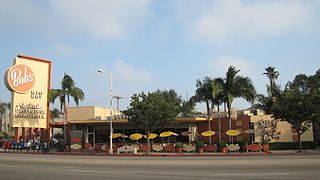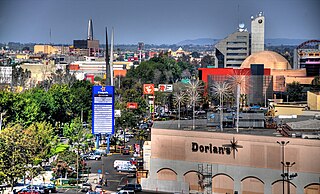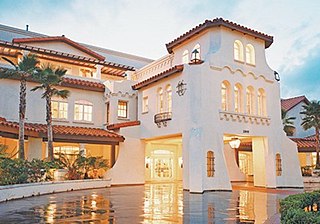
Tijuana is the largest city in the state of Baja California located on the northwestern Pacific Coast of Mexico. Tijuana is the municipal seat of the Tijuana Municipality and the hub of the Tijuana metropolitan area. It has a close proximity to the Mexico–United States border, which is part of the San Diego-Tijuana metro area.

Abelardo Rodríguez Luján, commonly known as Abelardo L. Rodríguez was the Substitute President of Mexico from 1932 to 1934. He completed the term of President Pascual Ortiz Rubio after his resignation, during the period known as the Maximato, when Former President Plutarco Elías Calles held considerable de facto political power, without being president himself. Rodríguez was, however, more successful than Ortiz Rubio had been in asserting presidential power against Calles's influence.

Jorge Hank Rhon is a Mexican businessman and owner of Mexico's largest sports betting company, Grupo Caliente. He served from December 2004 to February 2007 as the president of the municipality of Tijuana. He is the son of former Mexico City mayor Carlos Hank González and Guadalupe Rhon. Hank family has alleged links to drug trafficking. He has been accused of money laundering, murder, arrested for possession of unlicensed arms and dealing in the trade of exotic animals.
Agua Caliente, Aguas Calientes or Aguascalientes may refer to:
The Agua Caliente Band of Cahuilla Indians of the Agua Caliente Indian Reservation is a federally recognized tribe of the Cahuilla, located in Riverside County, California, United States. The Cahuilla inhabited the Coachella Valley desert and surrounding mountains between 5000 BCE and 500 CE. With the establishment of the reservations, the Cahuilla were officially divided into 10 sovereign nations, including the Agua Caliente Band.

Wayne Douglas McAllister was a Los Angeles-based architect who was a leader in the Googie style of architecture that embraced the automobile and the Space Age. Inspired by tail fins and gleaming chrome, he elevated the drive-in restaurant and the theme hotel to futuristic works of art. His 1941 El Rancho Vegas was the very first resort hotel on the Las Vegas Strip, and his iconic 1949 Bob's Big Boy restaurant in Burbank, California is a California historical landmark. He created iconic circular drive-in restaurants in Southern California, including Simon's, Herbert's, and Robert's in the 1930s.
XEBG-AM is a radio station in Tijuana, Baja California, Mexico, airing a Spanish and English pop and rock music format. It is known as Estéreo Baja and operated by Esquina 32.
Wirt G. Bowman was an American self-described capitalist. He was also an entrepreneur, speculator, casino owner, and one of the founders of the Agua Caliente Casino and Hotel in Tijuana, Baja California, Mexico.
The Caliente Hipódromo, formerly named the Agua Caliente Racetrack and the Agua Caliente Casino and Resort, is a resort and casino that includes a greyhound racing and former horse racing track in Tijuana, Baja California, Mexico. The racetrack opened in December 1929 at a cost of $2.5 million, while the adjacent Agua Caliente Casino and Hotel had opened in June 1928, later going defunct.
David Romero Flores is a Mexican jockey in American Thoroughbred horse racing.

In Caliente is a 1935 American romantic musical comedy film directed by Lloyd Bacon, starring Dolores del Río and Pat O'Brien. The film was written by Ralph Block and Warren Duff. The musical numbers were choreographed by Busby Berkeley. It was released by Warner Bros. on May 25, 1935.

Zona Río is an official zone, and the main modern business district, of the city of Tijuana, Mexico.
The Agua Caliente Handicap is a defunct thoroughbred horse race that was once the premier event at Agua Caliente Racetrack in Tijuana, Baja California, Mexico, and the richest race in North America. Inaugurated in 1917 as the Coffroth Handicap, it was named in honor of James Wood Coffroth, President of the Lower California Jockey Club. It was run at the Tijuana Racetrack through 1929 after which it was hosted by the newly built Agua Caliente Racetrack.

Agua Caliente is a historic entertainment center and present-day district of Tijuana, Baja California, at the southeastern end of the Centro borough. The Agua Caliente Tourist Complex formed in the late 1920s along Agua Caliente Boulevard when a road was built that led from the historic Rio Zone to a natural hot springs two miles up the Tijuana River Valley. Paramount icons of Tijuana developed in Agua Caliente such as the Agua Caliente Casino and Hotel and the Agua Caliente Racetrack. Today Agua Caliente is one of Tijuana's paramount tourist centers, the location of some of the city's most affluent neighborhoods, and also contains commercial and other offices along Boulevard Agus Caliente.
Agua Caliente Casino may refer to:
Gilpin Airlines, formally re-incorporated in 1932 as G & G Gilpin Air Lines Company was an air charter and airline company operated in California, Arizona, and the Mexican states of Sonora and Baja California from 1929 to 1934. A residual of the company persisted in Arizona as a flight school and charter business, operating out of Gilpin Field in Tucson, Arizona for several years. The airline is notable for its ownership by Arizona pioneer and politician Isabella Greenway, and for its involvement with trans-border traffic during the days of Prohibition.
The following is a timeline of the history of the city of Tijuana, Baja California, Mexico.
Grupo Caliente is one of the largest sports betting company in Mexico. In 2021 Grupo Caliente owned around 200 "off-track betting and bookmaking outlets" in Mexico, Austria, Brazil, Ecuador, Panama, Paraguay, Peru, Uruguay, Venezuela and the Caribbean. Business divisions of Grupo Caliente include Globalsat, Caliente Estadio, Caliente Online, and Caliente Casino. Owned Caliente Baja California, Caliente Casino is a chain of casinos operating mainly in the state of Baja California, Mexico, where it is the exclusive operator of casinos in Tijuana.

Carlsbad by the Sea (CBTS) is a continuing-care retirement community in the city of Carlsbad, California. It traces its history to the original mineral springs discovered in 1882 that was key in the development of the city. The retirement community was begun in the original Carlsbad Mineral Springs Hotel & Spa which was later demolished and replicated by the current structure. The history of CBTS was commemorated in 1998 by a historical marker at its Carlsbad site.








